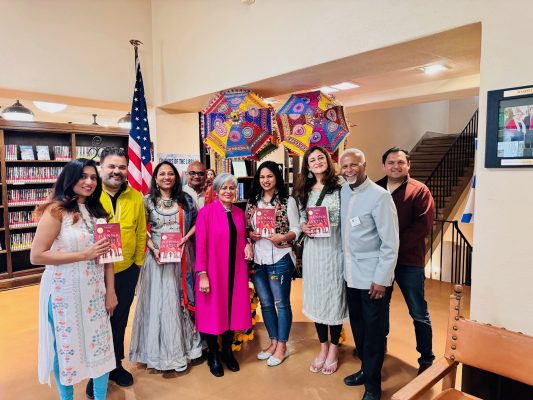
In what appears to be a familiar holiday tradition, a Manhattan Beach family of three sits around a board game in their comfortable apartment, decorated with paintings of California landscapes.
In this particular case, however, quite a bit more is going on. Jim and Kathleen Keifer and their daughter Lucy designed the game they are playing, including the artwork. They’re explaining what makes some games enjoyable again and again and others something that comes out of the closet once.
“Monopoly is your classic board game, but it’s not a great game,” says Jim, who designed games for Milton Bradley and Mattel before going independent. “It takes a long time and the player interaction is minimal. There are far better games than Monopoly for a family, but people are born knowing how to play it. You just know how to do it.”
“You’re a bad parent unless at some time you get your kid a set of Monopoly, even if nobody ever plays it,” Lucy observes. “What is most interesting is that nobody ever reads the directions, so that there are lots of house rules. The Free Parking rule, the idea that you can buy or trade properties with other players – those aren’t in the official rules.”
Though Keifers don’t expresses much fondness for Monopoly, Lucy admitted it has penetrated into our culture. ““There are a gazillion game metaphors, usually to do with chess and cards, but Monopoly contributed some. If you say “Go to jail and do not collect $200,” everybody knows what you mean.”
A different game helped Jim meet his Kathleen at the University of Notre Dame, where she was studying fine art and he was studying industrial design. Both were big tennis fans, and they played a match on their first date. After spending time designing shopping carts and popcorn poppers, Jim scored a summer internship with Mattel designing toys based on “He-Man, Master of the Universe.” As he explains it, his personal passions colored his suggestions.
“I came to just about every weekly meeting with ideas for games. They told me, Mattel doesn’t make games, sorry. I left there to work for Milton Bradley, a game manufacturer. When I returned to Mattel it was to head their new game design department.”
Jim had a string of hits, developing popular games like Uno, Rotten Apples, Bananagrams, Thunder Road and all the Harry Potter games. While he rose through the ranks at Milton Bradley and Mattel, Kathleen created art for advertising agencies and then for the toy industry. After a few years in the Midwest, and by now with three daughters, they moved first to Malibu and then to Manhattan Beach. Here Kathleen developed her distinctive style of California landscapes. Their defining element is her fascination with the color and character of light.
“I like painting real places, in a real moment in time. Sometimes I say, here’s a lifeguard tower, and here it is at a different times of day. I often go to look at something in morning light, in afternoon light, let’s see what happens when there’s a marine layer… There is something mysterious and beautiful about the light when we have Santa Anas. It’s very hard to capture the quality of that light with a camera. It’s something I experience in person and try to capture. I believe that there aren’t any ordinary moments, and bringing attention to a real moment in time is what I want to do in my art.
“A lot of my art is serendipitous. One time I walked past the alley by Fonz’s and the light was perfect – two chefs were having cigarettes in the alley. Everything was backlit in the golden hour, telephone wires in the background. You normally wouldn’t paint an alley, but it was beautiful.“
Kathleen’s contribution to the family game design business isn’t what you might expect from her paintings. Rather than suggest subtle details that might enhance the look, she is often in at the start.
“I participate in the game invention process as a high concept person, because what the manufacturers want is a game with an interesting package. Recently we were tossing around ideas and I said, goldfish bowl. They said, okay, probably pre-school if we do that, but we need a great name. I said “Fish and Chips,” and they immediately started designing the game. The pieces are contained in a goldfish bowl and moms like that.”
Moms? Why would moms be your main audience?
“Hundreds of millions of dollars are spent on games, largely spent by moms. Moms want games that are played by families and have a lot of eye contact. They want people sitting around the table looking at each other.”
That qualifies as one of those things you hear and immediately know is true. The best games engage the intellect and creativity of the players and give them the opportunity to interact on a basis that may be competitive, but not cutthroat.
That description would be perfect for a game invented by Lucy, a Mira Costa alumnus, who combined her lifelong interest in games with a passion for literature. Lucy has been published in the “Baker Street Journal,” an academic publication about the Sherlock Holmes stories, and has also created “Sherlock Holmes and Moriarty’s Web”, a game named after the great detective’s nemesis. Lucy says it bypasses the problems with all the previous games based on The Canon.

“The problem with the existing Holmes games is that you can really only play them once. It’s all about playing through a story, so it’s a deductive logic puzzle and once you have learned the strategy to solve it, it’s not fun any more. That’s a lot of people’s association with Holmes, and it’s kind of cold. But that’s not my impression at all. It’s Victorian. Look at how weird and funny these stories area. We’ve got all these crazy Americans with gold mines conning Englishmen, you have Inspector Lestrade showing up because someone is destroying busts of Napoleon. Things happen for weird reasons, and there are all these strange connections.”
So how do you make a game about a detective that doesn’t involve solving just one crime? And while you’re at it, how about having it not be so competitive that players finish it not liking each other?
“The game is for three to six players. Every person plays one of the characters from Sherlock Holmes, and you have powers based on that character’s personality. You don’t have to know all of them – all you really need to know is that Sherlock Holmes was a detective in Victorian England, Moriarty was organized crime before that was a thing, and that is it. It’s played on a regular table using tiles. Moriarty is in the middle, the unsolved crimes in London are on the outside, and you have to build a case, and it ends up looking like a web. Your job is to connect Moriarty to the crimes, and Moriarty, who you are playing against, is messing up your case. He is stealing evidence and kidnapping witnesses, so you keep having to rearrange things.”
The intricate art on the tiles is as stylish and professional as anything put out by major companies, and the cover art by Lucy’s sister Emily shows the great detective with his trademark deerstalker and pipe. (You might have guessed that her two sisters both studied art. Claire, the youngest sister, is responsible for social media and marketing.)
Moriarty’s Web has been tested at The Comic Bug in Manhattan Beach and at gaming conventions, and a Kickstarter campaign raised over $25,000 to produce the game. Lucy’s optimism is based on the long view of the Holmes phenomenon.
“We may not win over diehard Sherlock Holmes purists.. It has Sweeney Todd and Jack The Ripper jokes and it’s not meant to be pure, but we hope to win gamers over to reading the books and learning about the original work. Sherlock Holmes is one of the very few franchises that has been popular for a long period of time and been interpreted in so many different media. There was a Sherlock Holmes movie back in the silent era – it was lost for ages, but some buddies of mine were able to reconstruct one scene from bits and pieces. There have been plays, radio dramas, TV, and now games. Each generation has its own take on Sherlock Holmes. There have been Japanese and Chinese Sherlock Holmes and even a Soviet-era Russian Sherlock Holmes TV show. It’s really hard to get a hold of, but I’ve heard it’s fantastic. The only character since Holmes to capture the imagination that way is James Bond.”
Lucy is currently involved in manufacturing and licensing the game. She laughed when asked what her next project may be. She has an outline for “an awesome fantasy novel,” and other projects beckon. Given her houseful, she’ll have no shortage of inspiration. nor of collaborative help any time she asks for it.
Preorders for the game can be taken at moriartysweb@gmail.com – the price is $34.99.
B










